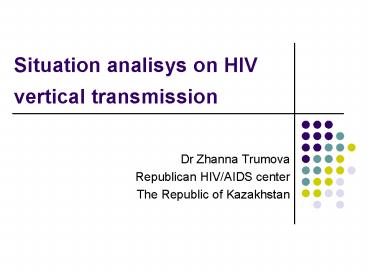Situation analisys on HIV vertical transmission - PowerPoint PPT Presentation
1 / 20
Title:
Situation analisys on HIV vertical transmission
Description:
Situation analisys on HIV vertical transmission. Dr Zhanna Trumova ... for target-groups (IDU, CSW, married couples, youth) as a supplement to ongoing ... – PowerPoint PPT presentation
Number of Views:77
Avg rating:3.0/5.0
Title: Situation analisys on HIV vertical transmission
1
Situation analisys on HIV vertical transmission
- Dr Zhanna Trumova
- Republican HIV/AIDS center
- The Republic of Kazakhstan
2
Number of HIV-infected people detected in
Kazakhstan (per year)
3
Spread of HIV/AIDS in Kazakstan (as of 01.09.03)
59 ??.
705 ??.
58 ??.
196 ??.
56??.
137 c?.
110 ??.
12 ??.
73 ??.
1210 ??.
38 ??.
7 ??.
19 ??.
62 ??.
185??.
368 ??.
3788 HIV-cases are registered in Kazakhstan
4
Ways and factors of HIV transmission
5
Prevalence of HIV - infected women by age groups
6
Growth rates of HIV-positive women
7
Number of pregnant women tested for HIV (per year)
8
Number of detected HIV-infected pregnant women
9
Prevalence of HIV-infected pregnant women by
region
Total - 205
10
Risk factors for HIV-infected pregnant women
11
Co-factors for HIV-infected pregnant women
12
Pregnancy outcomes
13
Spread of children by regionn75
14
Health status of children born to HIV-infected
mothers
15
Antiretroviral therapy of newborn, begun in 2002
16
Feeding of newborn , n81
17
Proposed preventive treatment schemes
- Scheme 1 ZDV (Protocol 076 from 14th week of
pregnancy to delivery (II and III trimesters of
pregnancy) 600 mg/pd from the beginning of
labour to delivery 2 mg/kg, then 1 mg/kg
intravenous per hour to the child suspension
ZDV 2 mg/kg every 6 hours in the course of 6
weeks) - Scheme 2 short-term treatment ZDV from 36th
week - Scheme 3 Nevirapin the pregnant 200 mg once
in delivery, the child nevirapin suspension 2
mg/kg once within 72 hours (HIVNET 012, Uganda)
18
Current activities
- A Government Dicree 1207 Programme on AIDS
prevention in Kazakhstan from 2001 till 2005
dated from 14 september 2001 was developed and
aproved in Kazakhstan. - Preventive Programmes aare being intriduced with
the assistance of international organizations. - Access to counselling and HIV voluntary testing
- Pregnant women and children are provided with
antiviral medicine and child nutrition free of
charge from public funds - Quality medical care and preventive interventions
are provided to HIV- infected women during
pregnancy and deliveries
19
Challenges
- Lack of information and educational materials on
HIV and pregnancy - Difficulties related to timely detection,
registration, examination of people from
risk-groups (drug addicts, RKS, etc) including
pregnant women - Weak VCT services network in health care,
including PHC, obs -genecologi , in particular
lack of professional training for health workers
in HIV/AIDS consultation - Lack of financing for equipment, test-systems,
antiviral medications
20
Possible solutions
- Primary prevention among pregnant women, access
to HIV/AIDS info, promotion of safe sex,
prevetion of unwanted pregnancy, availability of
contraceptives, STIs treatment - Introduction of voluntary consultation and
testing for target-groups (IDU, CSW, married
couples, youth) as a supplement to ongoing
prevention programmes - Prevention of mother-to-child HIV transmisstion
in antenatal, intranatal and postnatal periods - Access to antiretroviral medications
- Artificial feeding
- Care and support of HIV-infected women, their
children and family members































